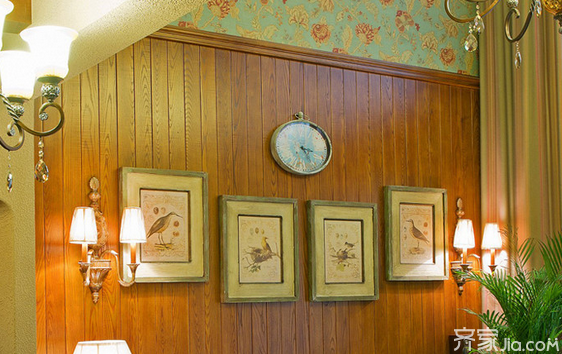Everyone knows that whether it is building a house or decorating a house, the biggest foundation is to ensure the security of the house. There is no security. Even the beautiful house will not work. However, during the renovation, many owners put the appearance of the house in the first place, thus neglecting Security, this will cause great security risks for the future of the home life, today Xiao Bian gave you talk about what actions seriously threaten the security of the housing!
First, arbitrarily change the bearing wall
1, wrong consequences
In order to change the spatial separation of the original living room, some occupants arbitrarily pierced the wall of the load-bearing wall and dismantled the walls connecting the balcony doors and windows, and some even directly dismantled the load-bearing wall, making the ring beam a housing load-bearing component and causing serious damage. The overall stiffness of the house. The consequences are light cracking and deformation, severe structural collapse, and building safety.

2, the correct approach
The importance of the load-bearing wall is mostly understood even by the renovation of the rookie, so the act of randomly demolition of the load-bearing wall should be relatively small. However, in many cases, the load-bearing wall was mistakenly removed because it did not distinguish the load-bearing wall from the non-bearing wall. Therefore, the decoration of white people still have to understand how to accurately distinguish load-bearing walls and non-load-bearing walls.
PS: Ways to distinguish load-bearing walls1, see the floor plan data
In the floor plan of the house, the walls marked with black on the drawing are load-bearing walls, and the walls marked with white parts are non-load-bearing walls. Such walls can be demolished and removed without affecting the building construction.
2, look at the structure of the house
In general, all walls of a brick-concrete structure are load-bearing walls. The external wall of a frame structure is a load-bearing wall, and the internal walls are generally not load-bearing walls.
3, see the grade of the house
General low-rise residential buildings, bungalows and villas are of brick-concrete structure, and their basic surfaces are load-bearing walls. The high-rise elevator buildings and western-style buildings are all frame structures.
4, see the thickness of the wall
Non-load-bearing walls are relatively thin, generally about 10 cm thick. A hand beat a beat, there is a crisp echo, is a light wall, and the load-bearing wall is generally more than 240MM thickness, knocking up is not much sound.

Second, free to change the function space
1, wrong consequences
It is very easy to cause accidents by changing the functional space of the house. For example, changing a kitchen into a bedroom is extremely dangerous because once the gas leaks, the consequences are unimaginable. There is also the option of changing the outer balcony into a kitchen or bedroom. This is also not advisable because the load-bearing weight of the outer balcony floor is generally not large, and changing into a kitchen or bedroom will increase the force of the balcony floor, which may result in a balcony floor. Break off.

2, the correct approach
After a rigorous feasibility review is required, the original functional space of the house can be changed.
Third, excessive use of overweight decoration materials
1, wrong consequences
In home decoration, large areas of marble, brick walls and complex suspended ceilings sometimes require the use of large amounts of overweight materials, which may cause the weight of the house to exceed the design standards, causing the building to lean and sink.

2, the correct approach
It is recommended not to use excessively heavy decoration materials. For example, when raising the ground, avoid using reinforced concrete with solid structure; when laying granite and marble, control the laying area as far as possible; the wall separating the room is best to use light steel keel or wood structure filled with noise insulation material; In the ceiling, the structure should be simplified and lightweight materials should be used.
Fourth, extensive use of flammable materials
1, wrong consequences
In the decoration, a large number of flammable and non-fireproof decorative materials are used. Such as wooden floors, wooden wall skirtings, wooden ceilings, plastic products, wallpapers, wall coverings, carpets, etc. When these materials are involved in a fire, it will encourage the spread and expansion of fire, resulting in life safety and property damage.

2, the correct approach
It is advisable to use aluminum-plastic decorative plates, aluminum alloy keels, gypsum products, natural stone, and floor tiles to ensure the safety of non-flammable or flame-retardant decorative materials. In addition, even if it is unavoidable to use flammable decoration materials, it is necessary to use them before use. Do a good job of fireproofing materials.
Tips: More practical decoration knowledge, real scene with the shoot, please pay attention to the palm of this site (micro signal: mall_jia).
Decoration construction knowledge
Galvanized Steel Fence
Steel fence is also known as steel picket fence, ornamental steel fence. The panels are manufactured using the highest-strength steel pickets and rails, and are available in a wide range of sizes and styles. Material: Galvanized steel Q195 or Q235 Finish: galvanized and powder coated Main market: America, Canada, Australia, Europe, etc
Galvanized Steel Fence,Prefabricated Steel Fence,Galvanized Steel Fence Post,Galvanized Steel Pipe Fence
HeBei Bosen Metal Products Co.,Ltd , https://www.hbbosenfence.com
